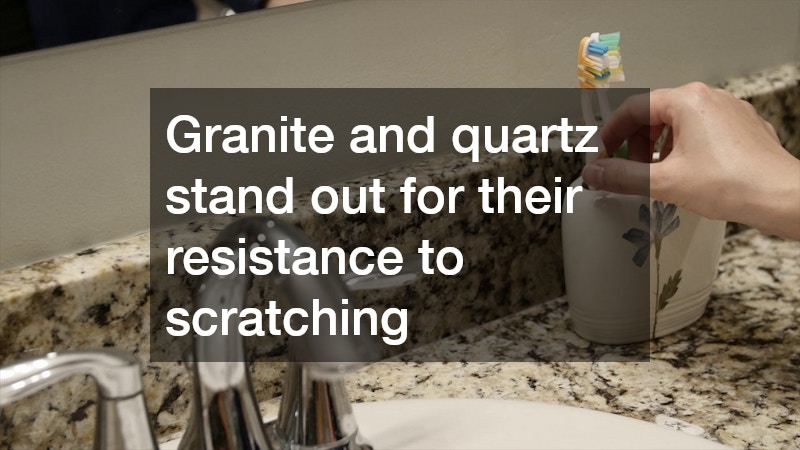In this article, we will explore the various options for bathroom countertops, focusing on their materials, durability, maintenance, and aesthetics to help you make an informed choice. With so many styles and finishes available, selecting the right countertop can feel overwhelming. From high-end natural stones to cost-effective engineered surfaces, each option brings its own set of benefits and considerations.
By understanding these differences, you can choose a countertop that fits your style, stands up to daily use, and enhances your bathroom’s overall look. Let’s examine the most common countertop materials for bathrooms and what makes each one unique.
What Are the Most Common Materials for Bathroom Countertops?
Countertops come in a variety of materials, each offering unique benefits and aesthetics.
The most common bathroom countertop materials include granite, quartz, marble, laminate, and solid surface options. Each material presents its distinct characteristics and serves different needs, making them popular choices for homeowners. For instance, granite offers a natural stone appeal, while laminate provides budget-friendly versatility. Solid surface materials, such as Corian, are also gaining popularity for their seamless appearance and ability to be easily repaired if scratched.
Granite is known for its durability and unique veining patterns, while quartz, engineered from natural stone mixed with resins, offers a wide range of colors and low maintenance. Marble, although stunning with its classic beauty, is more porous and requires careful maintenance to avoid staining. Laminate countertops, on the other hand, are lightweight and available in numerous patterns that mimic stone or wood, making them an excellent choice for quick bathroom updates. If you want a fully customizable option, solid surface materials can even be molded to include integrated sinks or backsplashes.
How Do I Choose a Bathroom Countertop Based on Durability and Maintenance?
Understanding the durability and maintenance requirements of different materials is crucial for selecting the right countertop for your bathroom.
Durability is a key factor, especially in a room that sees daily use and moisture exposure. Granite and quartz stand out for their resistance to scratching and staining, making them excellent long-term investments. Quartz is also non-porous, meaning it resists bacteria and mold—an important consideration in humid bathrooms. Conversely, softer materials like marble may require a sealing treatment to protect against water damage and may develop a patina over time, which can add character but may not appeal to everyone.
Maintenance also varies significantly between materials. For instance, granite and quartz can usually be cleaned with mild soap and water, while marble may need specialty cleaners to avoid damaging its finish. Laminate is low-maintenance but prone to heat and moisture damage if not properly sealed at the edges. Solid surface countertops can be lightly sanded to remove surface scratches, making them easy to refresh. Be sure to consider how much time and effort you are willing to dedicate to upkeep when making your selection, as this can significantly influence the countertop’s longevity.
What Are the Design Considerations for Bathroom Countertops?
The design and style of your bathroom can greatly influence your choice of countertop materials and colors, ensuring a cohesive look.
Your bathroom’s overall aesthetic—whether traditional, modern, or eclectic—should guide your countertop choice. For a sleek, contemporary look, quartz or solid surface materials can provide seamless designs and vibrant colors that match custom cabinetry. Alternatively, if you prefer a rustic or classic theme, materials like natural stone can enhance that aesthetic with their unique textures. Granite with bold veining or marble with soft, elegant swirls can act as a focal point, tying together other design elements.
Color plays a crucial role; lighter countertops can make small bathrooms appear larger and brighter, while darker hues may offer a dramatic contrast against lighter cabinetry. Textured or patterned surfaces can add visual interest, especially in minimalist designs. Additionally, consider the existing tiles, fixtures, and accent pieces, ensuring that your countertop complements and enhances your existing décor for a harmonious bathroom design. Integrated backsplashes, edge profiles, and sink styles can also influence the final look, so it’s worth reviewing samples in your bathroom’s lighting before making a decision.
Choosing the right bathroom countertop option involves considering various factors such as material, durability, maintenance, and design. With the right decision, you can enhance your bathroom’s functionality and aesthetic appeal. Remember to balance your personal style with practical needs, such as resistance to moisture and ease of cleaning. Taking time to compare options, review samples, and consult professionals can help you invest in a countertop that will serve you well for years to come.



